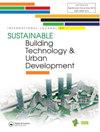特殊就业工场残障人士工场建筑设计
Q4 Engineering
International Journal of Sustainable Building Technology and Urban Development
Pub Date : 2023-03-23
DOI:10.32629/jbt.v5i1.1161
引用次数: 0
摘要
特殊就业中心和职业中心对残疾人的社会劳动融合具有巨大的相关性。接下来的工作试图将工作研究、人体工程学和人体测量学的基本技术引入这类中心,这些技术组织在一个程序中,有助于调整工作,以适应残疾人的能力,通过同样的建筑设计作为促进上述整合的另一个工具。在此过程中,对每个活动所需的身体、心理和感官需求进行了分析,并在此基础上对这些人在其位置上的表现进行了必要的适应性分析,并进行了同样的建筑重新设计。在整个研究过程中,检查表、访谈、问卷调查和人体测量设计等技术和工具被用作开发所研究位置的建筑设计的基本技术,同时考虑到对残疾人的必要适应。本文章由计算机程序翻译,如有差异,请以英文原文为准。
Architectural Design of Jobs for People with Disabilities in Special Employment Workshops
Special employment centers and occupational centers have enormous relevance for the socio-labor integration of people with disabilities. The following work tried to bring to this type of centers the basic techniques of work study, ergonomics and anthropometry organized in a procedure that contributes to the adjustment of jobs to the capacities of people with disabilities through the architectural design of the same as one more tool that facilitates the aforementioned integration. With the procedure, the physical, psychological and sensory demands that are required for each activity were analyzed and, based on this, an analysis of the necessary adaptations for the performance of these people in their positions was carried out, proceeding to the architectural redesign of the same. Throughout the research, techniques and tools such as checklists, interviews, questionnaires and anthropometric design were used as a fundamental technique to develop the architectural design of the positions under study, taking into consideration the necessary adaptations to the person with a disability.
求助全文
通过发布文献求助,成功后即可免费获取论文全文。
去求助
来源期刊

International Journal of Sustainable Building Technology and Urban Development
Engineering-Building and Construction
CiteScore
1.20
自引率
0.00%
发文量
0
期刊介绍:
The International Journal of Sustainable Building Technology and Urban Development is the official publication of the Sustainable Building Research Center and serves as a resource to professionals and academics within the architecture and sustainability community. The International Journal of Sustainable Building Technology and Urban Development aims to support its academic community by disseminating studies on sustainable building technology, focusing on issues related to sustainable approaches in the construction industry to reduce waste and mass consumption, integration of advanced architectural technologies and environmentalism, sustainable building maintenance, life cycle cost (LCC), social issues, education and public policies relating to urban development and architecture .
 求助内容:
求助内容: 应助结果提醒方式:
应助结果提醒方式:


